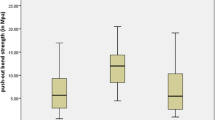Abstract
Few reports have addressed the effects of diode laser irradiation at 980 nm on the morphology and fracture resistance of dentine. The purpose of this study is to evaluate the effects of 980-nm diode laser on the ultrastructure and fracture resistance of root dentine. The roots of 90 extracted canine teeth were divided into three groups according to the type of irrigating solution (water, NaOCl, and NaOCl/EDTA) and subdivided into three subgroups (n = 10) according to the amount of laser irradiation (without irradiation, 1.5 W/100 Hz and 3.0 W/100 Hz). The roots were filled with an epoxy resin-based sealer and gutta-percha and then subjected to a fracture resistance test. Data were analyzed by ANOVA and the Tukey test (p < 0.05). Additionally, 18 canine teeth were prepared using the same irrigation/irradiation protocols and evaluated by scanning electron microscopy (SEM). The SEM showed greater changes when the laser power increased, and the changes also varied according to the irrigating solution. A modified smear layer was observed in specimens that were treated with water and then laser-irradiated. The laser treatment did not alter the fracture resistance of roots treated with 1.5 W/100 Hz (246.3 ± 29.5 N) and 3.0 W/100 Hz (215.3 ± 25.1 N) laser power. The roots treated with NaOCl were more susceptible to fracture (199.4 ± 15.1 N) than those irrigated with water (254.2 ± 23.0 N) (p < 0.05). The 980-nm diode laser altered the morphology of the dentine but did not affect the fracture resistance of the roots.




Similar content being viewed by others
References
Moritz A, Gutknecht N, Goharkhay K, Schoop U, Wernisch J, Sperr W (1997) In vitro irradiation of infected root canals with a diode laser: results of microbiologic, infrared spectrometric, and stain penetration examinations. Quintessence Int 28:205–209
Romanos G, Nentwig GH (1999) Diode laser (980 nm) in oral and maxillofacial surgical procedures: clinical observations based on clinical applications. J Clin Laser Med Surg 17:193–197
Gutknecht N, Franzen R, Meister J, Vanweersch L, Mir M (2005) Temperature evolution on human teeth root surface after diode laser assisted endodontic treatment. Lasers Med Sci 20:99–103
Michiels R, Vergauwen TE, Mavridou A, Meire M, Bruyne M, Moor RJ (2010) Investigation of coronal leakage of root fillings after smear-layer removal with EDTA or Nd:YAG lasing through capillary-flow porometry. Photomed Laser Surg 28:43–50
Gutknecht N, Franzen R, Schippers M, Lampert F (2004) Bactericidal effect of a 980-nm diode laser in the root canal wall dentin of bovine teeth. J Clin Laser Med Surg 22:9–13
Schoop U, Kluger W, Dervisbegovic S, Goharkhay K, Wernisch J, Georgopoulos A, Sperr W, Zehnder M (2006) Root canal irrigants. J Endod 32:389–398
Marchesan MA, Brugnera-Junior A, Souza-Gabriel AE, Silva SRC, Sousa-Neto MD (2008) Ultrastructural analysis of root canal dentine irradiated with 980-nm diode laser energy at different parameters. Photomed Laser Surg 26:235–240
Alfredo E, Souza-Gabriel AE, Silva SR, Sousa-Neto MD, Brugnera-Junior A, Silva-Sousa YT (2009) Morphological alterations of radicular dentine pretreated with different irrigating solutions and irradiated with 980-nm diode laser. Microsc Res Tech 72:22–27
Esteves-Oliveira M, Guglielmi CAB, Ramalho KM, Arana-Chavez VE, Eduardo CP (2010) Comparison of dentin root canal permeability and morphology after irradiation with Nd:YAG, Er:YAG, and diode lasers. Lasers Med Sci 25:755–760
Wang X, Sun Y, Kimura Y, Kinoshita J, Ishizaki NT, Matsumoto K (2005) Effects of diode laser irradiation on smear layer removal from root canal walls and apical leakage after obturation. Photom Laser Surg 23:575–581
Coluzzi DJ (2000) An overview of laser wavelengths used in dentistry. Dent Clin North Am 44:753–761
Alfredo E, Marchesan MA, Sousa-Neto MD, Brugnera-Junior A, Silva-Sousa YTC (2008) Temperature variation at the external root surface during 980-nm diode laser irradiation in the root canal. J Dent 36:529–534
Hülsmann M, Heckendorff M, Lennon A (2003) Chelating agents in root canal treatment: mode of action and indications for their use. Int Endod J 36:810–830
Marchesan MA, Brugnera-Junior A, Ozorio JE, Pécora JD, Sousa-Neto MD (2008) Effect of 980-nanometer diode laser on root canal permeability after dentin treatment with different chemical solutions. J Endod 34:721–724
Alfredo E, Silva SRC, Ozório JEV, Sousa-Neto MD, Brugnera-Junior A, Silva-Sousa YTC (2008) Bond strength of AH Plus and Epiphany sealers on root dentine irradiated with 980 nm diode laser. Int Endod J 41:733–740
Moritz A (2006) Innovative wavelengths in endodontic treatment. Lasers Surg Med 38:624–630
Faria MIA, Souza-Gabriel AE, Marchesan MA, Sousa-Neto MD, Silva-Sousa YTC (2008) Ultrastructural evaluation of radicular dentin after Nd:YAG laser irradiation combined with different chemical substances. Gen Dent 56:641–646
Zou L, Shen Y, Li W, Haapasalo M (2010) Penetration of sodium hypochlorite into dentin. J Endod 36:793–796
White JD, Lacefield WR, Chavers LS, Eleazer PD (2002) The effect of three commonly used endodontic materials on the strength and hardness of root dentin. J Endod 28:828–830
Marending M, Luder HU, Brunner TJ, Knecht S, Stark WJ, Zehnder M (2007) Effect of sodium hypochlorite on human root dentine—mechanical, chemical and structural evaluation. Int Endod J 40:786–793
Surapipongpuntr P, Duangcharee W, Kwangsamai S, Ekka A (2008) Effect of root canal irrigants on cervical dentine permeability to hydrogen peroxide. Int Endod J 41:821–827
Vilanova WV, Carvalho-Junior JR, Alfredo E, Sousa-Neto MD, Silva-Sousa YT (2012) Effect of intracanal irrigants on the bond strength of epoxy resin-based and methacrylate resin-based sealers to root canal walls. Int Endod J 45:42–48
Author information
Authors and Affiliations
Corresponding author
Rights and permissions
About this article
Cite this article
Faria, M.I.A., Sousa-Neto, M.D., Souza-Gabriel, A.E. et al. Effects of 980-nm diode laser on the ultrastructure and fracture resistance of dentine. Lasers Med Sci 28, 275–280 (2013). https://doi.org/10.1007/s10103-012-1147-7
Received:
Accepted:
Published:
Issue Date:
DOI: https://doi.org/10.1007/s10103-012-1147-7




